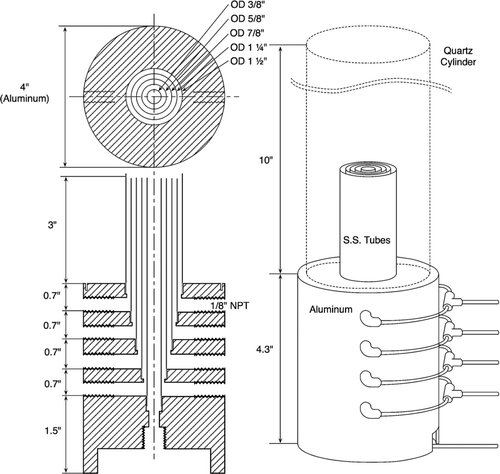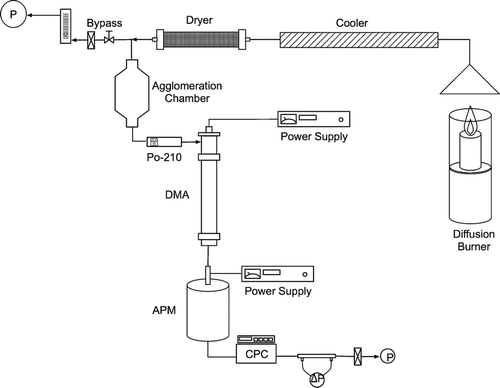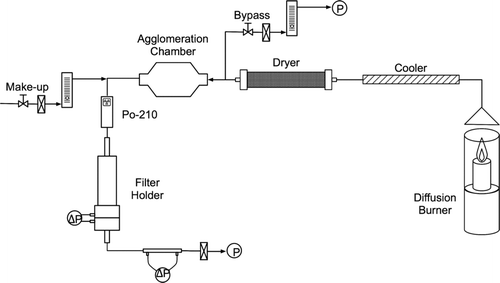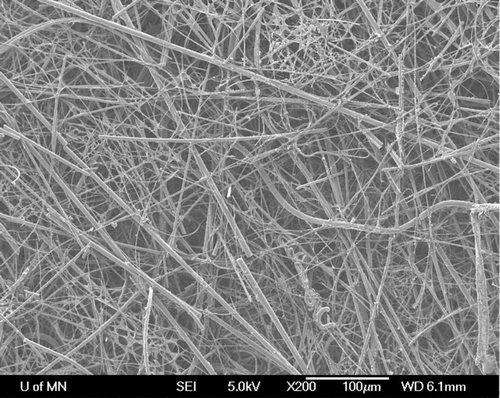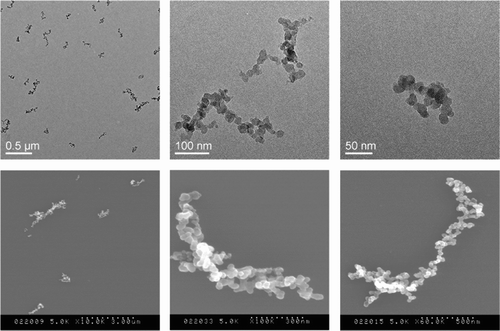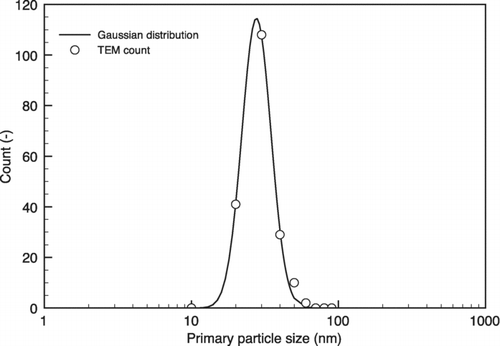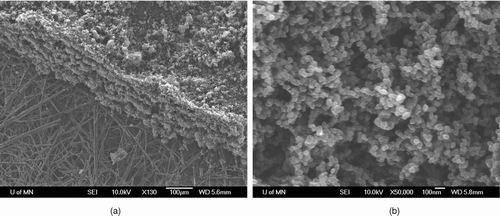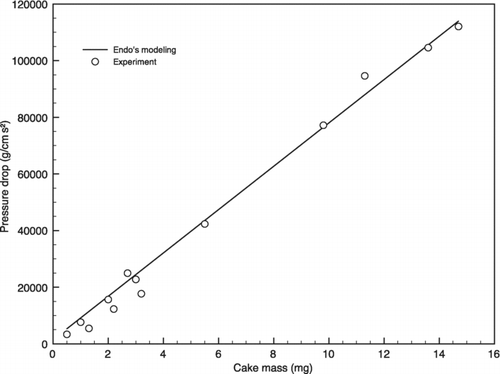Abstract
Nanoparticle agglomerates are pervasive in atmospheric sciences, air pollution, and manufacturing of powdered materials, yet studies for filtration of nanoparticle agglomerates are still scarce compared to those for spherical particles. We investigated loading of soot nanoparticle agglomerates on fibrous air filter media. The soot agglomerates were generated from a diffusion burner with propane gas as fuel and compressed air as oxidant/sheath. The mode of the number distribution was determined to be 120 nm. A Differential Mobility Analyzer (DMA)—Aerosol Particle Mass Analyzer (APM) system was used to measure the mass of agglomerates as a function of the mobility size, which gave a mass-mobility exponent of 1.9 ± 0.1. Using transmission electron microscopy (TEM), we found that the primary particles in the agglomerates had a mean diameter of 28 nm with a geometric standard deviation of 1.26. Loading experiments were carried out with the face velocity of 10 cm/s on a fiberglass filter media. The pressure drop increased approximately linearly with the loading mass. The porosity of the cakes was calculated using cake mass and cake thickness, and the average cake porosity was 0.95. We found that the model of CitationEndo et al. (1998) for cake loading was applicable to soot agglomerate loading. The cake could be regarded as formed by primary particles in soot agglomerates, and agglomerates are indistinguishable once deposited in the cake. When the size distribution of the primary particles was used in the model of Endo et al. good agreement between the experimental and computed results was obtained.
1. INTRODUCTION
Filtration of nanoparticles is becoming an important issue as they are manufactured in large quantities and also produced as byproducts from combustion. They may pose a serious health risk because of the increased toxicity due to the large specific surface area (CitationOberdörster et al. 2005; CitationMaynard and Kuempel 2005). A number of studies of filtration of nanoparticles down to 2–3 nm with spherical or similar shapes have been reported (CitationIchitsubo et al. 1996; CitationAlonso et al. 1997; CitationHeim et al. 2005; CitationKim et al. 2007; CitationWang et al. 2007; CitationShin et al. 2008). Compared to spherical particles, studies of filtration of nanoparticle agglomerates, which are made up of clusters or chains of nanosize spherules (primary particles), are still scarce. Such agglomerates are often produced by high temperature processes leading to a solid particle. Combustion is a primary source including diesel particle and soot from building fires. Combustion processes are also used to manufacture a variety of materials in agglomerate form including fumed silica, titanium dioxide, and carbon black. CitationFu et al. (1990) studied the filtration of chain aggregate aerosols using a screen type filter. The iron oxide chain aggregates had mean lengths in the range of 1,500–3,200 nm. The primary sphere size ranged from 17–41 nm. CitationLange et al. (1999) measured the filtration efficiency of fibrous filters for carbon agglomerates and for spherical particles as a function of the mobility diameter. They derived a filtration model based on the interception equivalent diameter of agglomerates, which was defined as the diameter of a spherical particle diameter having the same penetration as that of the agglomerate. CitationKim et al. (2009) studied filtration of silver nanoparticle agglomerates by fibrous filters. In their experiments a sintering furnace was used to change the morphology of the agglomerates from a chain-type open structure to a fully sintered structure with a spherical shape. This allowed a direct comparison between the filtration efficiency of the agglomerate and that of a sphere with the same mobility diameter and material density. CitationKim et al. (2009) found that agglomerate particles showed lower penetration due to their larger interception length compared with spherical particles with the same mobility diameters.
Understanding the loading process of nanoparticle agglomerates is of great importance for practical filtration systems. The pressure drop across a filter can rise rapidly under heavy particle loading conditions, which can lead to high cost due to installing large capacity blowers or replacing filters. The loading process for fibrous and membrane filters generally proceeds through four regimes: (1) clean filter filtration, (2) initial depth filtration, (3) transition filtration, and (4) dust cake filtration (CitationJapuntich et al. 1997). Many studies have been devoted to dust cake filtration of spherical particles, but there is little study investigating the dust cake loading characteristics of nanoparticle agglomerates. Schmidt and Löffeler (Citation1990, Citation1991) developed a method to freeze the dust cake structure for subsequent microscopic examination. Using this technique, CitationSchmidt (1995) found that the porosity of dust cake layer decreased with increasing pressure loss, and the local area porosities increased with increasing filter medium surface. CitationCross et al. (1995) developed a monitoring system for the mass and tension of bag filters. CitationHöflinger et al. (1994) numerically simulated deposition of spherical particles on a filter and formation of the dust cake. CitationTheliander and Fathi-Najafi (1996) performed simulation based on the division of a dust cake layer into may fine thin layers. CitationJeon and Jung (2004) developed a simulation method to study the effect of particle size on the compression behavior of dust cakes composed of monodisperse aerosols.
CitationEndo et al. (1998) performed experiments to measure, in real time, the pressure drop and the height of the dust cake. They paid special attention to the effects of the particle size distribution and particle shape and derived an analytical expression to correlate the pressure drop with the aforementioned particle properties. CitationChoi et al. (2004) investigated dust cake compressibility of fine fly ashes on a ceramic filter. They developed expressions for cake porosity and pressure drop across the dust cake based on the equation proposed by CitationEndo et al. (1998) and found good agreement with experimental results. CitationValmari et al. (2006) studied filter clogging by bimodal aerosol and found that the cake filtration of coarse particles alone resulted in a faster clogging rate as compared to the same amount of coarse particles accompanied with fine particles. In our experiments, we characterized soot agglomerates generated by a diffusion burner, and conducted cake loading tests using a fibrous filter. Furthermore, we applied CitationEndo et al. (1998) modeling to soot agglomerate loading by measuring primary particle size distribution of agglomerates.
2. EXPERIMENTAL SETUP
Soot particles in our experiments were generated by a diffusion burner and its structure is shown in . The bottom part of the burner was an aluminum cylinder composed of five concentric rings. Propane gas was fed into the center ring at the bottom and served as the fuel and compressed air was fed into the rest of the rings as oxidant and sheath gas. The gases flowed through the stainless steel tubes and formed the flame. A tube with a diameter of 2 cm was used to collect soot particles from the flame. Soot particles generated by the diffusion burner passed through a cooling tube and a diffusion dryer to remove any excessive heat and humidity.
We measured a number of parameters of the soot agglomerates, including the mobility diameter, individual agglomerate mass, and primary sphere size. The mobility diameter was measured by a Differential Mobility Analyzer (DMA) and the mass was measured by an Aerosol Particle Mass Analyzer (APM). shows the schematic diagram of the DMA-APM system to measure soot agglomerates in real time. The soot particles from the burner first went through a cooling tube and a diffusion dryer, then entered an agglomeration chamber. The agglomeration chamber was an empty aluminum chamber with a volume of 2 liter, which provided a residence time of 2 min when the flow rate was 1 lpm. The long residence time promoted agglomeration among soot particles and increased the size of the agglomerates. The agglomerates passed through a Po-210 neutralizer to be bipolarly charged to the Boltzmann equilibrium charge distribution. The DMA was then used to fractionate agglomerates according to their mobility size; the particle size was controlled by adjusting the DMA voltage. After the DMA, agglomerates of a certain mobility size entered the APM and the mass was measured. The APM consists of two cylindrical electrodes rotating together at the same controlled speed (∼3,000 rpm). A voltage is applied to the inner electrode with the outer electrode grounded. Particles are introduced into the small gap between two electrodes and experience centrifugal and electrostatic forces. The APM transmits particles of a known mass (independent of particle shape or composition), determined by the balance of the centrifugal and electrostatic forces (CitationEhara et al. 1996). The DMA-APM system was calibrated using NIST-Traceable polystyrene latex spheres (PSL) in order to ensure proper operation and establish experimental uncertainty.
shows the schematic of the filter loading system with soot agglomerates. The part for soot agglomerate generation, including the burner, the cooling tube, the agglomeration chamber and the dryer, was the same as in . Before entering the filter holder, the soot agglomerates passed through a Po-210 neutralizer, bringing them to a Boltzmann charge distribution. They then entered the filter holder and loaded on the filter. The diameter of the filter was 57 mm with an effective filtration area of 17.34 cm2. The pressure drop across the filter was measured using a pressure gage. The flow rate was measured with a laminar flow element downstream of the filter holder and could be adjusted by a valve.
The filter used in the loading experiments was HE 1071, a fiberglass media manufactured by Hollingsworth and Vose. Characteristic parameter of HE 1071 are listed in and an image of HE 1071 from Scanning Electron Microscopy is shown in .
TABLE 1 Characteristic parameters for the filter media HE 1071
3. RESULTS FOR SOOT AGGLOMERATES CHARACTERIZATION
We measured the mobility size distribution of the soot agglomerates by a Scanning Mobility Particle Sizer (SMPS). shows the number distribution as a function of the mobility diameter; the mode was about 120 nm. Using the DMA-APM system, the mass of agglomerates can be determined as a function of the mobility diameter. The raw data from APM are number concentration versus voltage and need deconvolution to give the particle mass. We used a procedure developed by CitationEmery (2007) to fit a DMA-APM transfer function to the data, determine the peak voltage and convert this voltage to mass. Based on the PSL calibrations we consider the mass measurements to be accurate within 7%.
FIG. 5 Number distribution of the soot agglomerates as a function of the mobility diameter; the mode of the distribution is 120 nm.
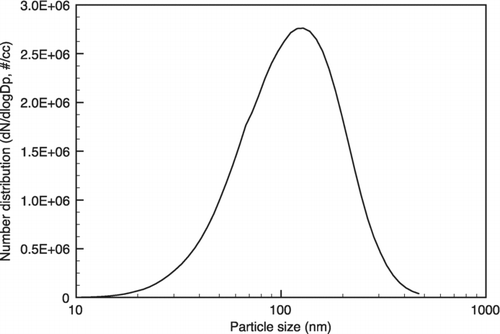
Data for soot agglomerates are shown in . The following power law expression is used to fit the data:
We performed extensive studies of the soot agglomerates using electron microscopy (EM). Examples of the images are shown in . The geometric length of the agglomerates ranged from below 100 nm to a couple of microns, which is longer than the corresponding mobility diameter. The loose structure of the agglomerates results in higher aspect ratios compared to spherical particles with the same drag force and mobility diameter. The agglomerates were composed of primary particles of nearly spherical shape, and we measured the primary particle size distribution from a large number of images following the approach of CitationKim et al. (2009) and CitationShin et al. (2009). Distinguishable primary particles were identified on EM images and the diameters were measured using an image processing software ImageJ (a public domain Java image processing program, http://rsb.info.nih.gov/ij/). shows the count number as a function of the primary particle size measured from TEM images. This distribution was fitted into a log-normal distribution. From the sizes of 190 primary spheres analyzed, we found that the mean diameter was 28 nm with a geometric standard deviation of 1.26.
4. RESULTS FOR SOOT AGGLOMERATES LOADING
Loading experiments with soot agglomerates were performed with the face velocity of 10 cm/s. A total number of 12 tests were carried out; the loading time was varied in these tests but other conditions were kept the same. Examples of SEM images of soot particle cakes on filters are shown in . a shows a boundary of a soot agglomerate cake on a fibrous filter media which includes a clean filter area and a soot particle cake area in one image, and is a magnified image of the surface of the cake which shows typical cake loading.
Filter mass changes were measured after the loading tests with the accuracy of 0.1 mg. Possible humidity in filter media and particle cake was removed by sitting the filter in a desiccant chamber for 24 h before each mass measurement. We measured the cake thickness using a video enhanced microscope (VEM, Nikon, 0.2 μm ultimate resolution). The focus of the microscope was first placed on the top surface of the cake, then we moved the sample stage until the focus was on the bottom of the cake, i.e., the top surface of the filter. The displacement of the sample stage was measured by a digital indicator and gave one measurement of the cake thickness. It can be seen from that the surface of the cake was rugged, thus several measurements were performed at different locations on the cake surface and the average value was taken as the cake thickness. Considering the minimum displacement of the sample stage which is 1 μm and also taking into account the uncertainty in determining the optical focus, we estimated that the accuracy of the thickness measurement was 2.5 μm. With the cake mass Mc and thickness H, we can compute the average porosity in the entire cake layer as
TABLE 2 Measured values of the cake mass, thickness, and porosity from the 12 loading tests
The initial pressure drop across the clean filter is denoted as ΔP0. The pressure drop across the filter ΔP was monitored during the loading process and the final pressure drop when the test ended was recorded. The increased pressure drop (ΔP – ΔP0) was due to the loaded particles. We plot the final increased pressure drop as a function of the loading mass in . It can be seen that the pressure drop increases approximately linearly with the loading mass.
5. COMPARISON WITH THE MODEL OF CitationENDO ET AL. (1998)
To better understand the experimental results, we look at the analytical expression derived by CitationEndo et al. (1998). The authors assumed that the particle size distribution followed the log normal distribution and showed that the pressure drop of the cake layer ΔPc
The void function υ(ϵ) indicates the effects of neighbor particles and takes into account the change of the apparent viscosity of fluid depending on the porosity or particle concentration. We used following void function (CitationEndo et al. 1998)
The results computed using Equation (Equation4) are shown as the solid line in . It can be seen that the experimental and computed results agree well with each other. This demonstrates that Equation (Equation3) is applicable for loading of agglomerates and the size distribution of primary particles should be used in the model.
6. CONCLUSIONS
We performed loading tests using soot agglomerates on a fiber glass filter media. The soot agglomerates were generated using a diffusion burner. Significant effort was spent on characterization of the soot agglomerates. The mobility diameter of the soot agglomerates was measured by a DMA and the mode of the number distribution was 120 nm. A DMA-APM system was used to measure the mass of agglomerates as a function of the mobility size. This function was fit into a power law and the exponent was a mass-mobility exponent, which characterized the power law dependence of mass on a mobility size. The exponent was 1.9 ± 0.1 in our study, which was similar to the mass-mobility exponent of soot particles in the literature. We performed extensive studies of the soot agglomerates using electron microscopy (EM). The sizes of 190 primary particles were measured form EM images and fit into a log-normal distribution. We found that the mean diameter was 28 nm with a geometric standard deviation of 1.26.
Loading experiments were carried out with the face velocity of 10 cm/s on a fiberglass filter media. Loading time was varied in our tests but other conditions were kept the same. In each test, the final loading mass, cake height, and pressure drop were measured and recorded. The pressure drop increased approximately linearly with the loading mass. The porosity of the cakes was calculated and the average value was 0.95. It was found that the model of CitationEndo et al. (1998) for cake loading was applicable to soot agglomerate loading. The cake could be regarded as formed by primary particles in soot agglomerates, and agglomerates are indistinguishable once deposited in the cake. When the size distribution of the primary particles was used in the model of Endo et al. good agreement between the experimental and computed results was obtained.
The authors thank the support of members of the Center for Filtration Research: 3M Corporation, Boeing Company, Cummins Filtration Inc., Donaldson Company, Inc., E. I. du Pont de Nemours and Company, Entegris Inc, Samsung Semiconductor Inc., Shigematsu Works CO., LTD, TSI Inc., and W. L. Gore & Associates and the affiliate member National Institute for Occupational Safety and Health (NIOSH). Parts of this work were carried out in the University of Minnesota I.T. Characterization Facility, which receives partial support from NSF through the NNIN program. Also, Jacob H. Scheckman acknowledges support from National Science Foundation Grant BES-0646507.
REFERENCES
- Alonso , M. , Kousaka , Y. , Hashimoto , T. and Hashimoto , N. 1997 . Penetration of Nanometer-Sized Aerosol Particles Through Wire Screen and Laminar Flow Tube . Aerosol Sci. Technol. , 27 : 471 – 480 .
- Choi , J.-H. , Ha , S.-J. and Jang , H.-J . 2004 . Compression Properties of Dust Cake of Fine Fly Ashes from a Fluidized Bed Coal Combustor on a Ceramic Filter . Powder Technol. , 140 : 106 – 115 .
- Cross , J. A. , Helstroom , R. and Beck , R. 1995 . Method for Continuously Monitoring the Weight and Tension of Filter Bags in a Fabric Filter System . Filtration & Separation. , 32 ( 5 ) : 443 – 447 .
- Ehara , K. , Hagwood , C. and Coakley , K. J. 1996 . Novel Method to Classify Aerosol Particles According to Their Mass-to-Charge Ratio-Aerosol Particle Mass Analyze . J. Aerosol Sci. , 27 : 217 – 234 .
- Emery , M. S. 2007 . “ Theoretical Analysis of Data from DMA-Apm System, in Mechanical Engineering ” . Minneapolis, , USA : University of Minnesota .
- Endo , Y. , Chen , D.-R. and Pui , D. Y. H. 1998 . Effects of Particle Poly-dispersity and Shape Factor During Dust Cake Loading on Air Filters . Powder Technol. , 98 ( 3 ) : 241 – 249 .
- Fu , T. H. , Cheng , M. T. and Shaw , D. T. 1990 . Filtration of Chain Agglomerate Aerosols by Model Screen Filter . Aerosol Sci. Technol. , 13 : 151 – 161 .
- Heim , M. , Mullins , B. , Wild , M. , Meyer , J. and Kasper , G. 2005 . Filtration Efficiency of Aerosol Particles Below 20 Nanometers . Aerosol Sci. Technol. , 39 : 782 – 789 .
- Höflinger , W. , Stöcklmayer , C. and Hackl , A. 1994 . Model Calculation of the Compression Behaviour of Dust Filter Cakes . Filtration & Separation. , 31 ( 8 ) : 807 – 811 .
- Ichitsubo , H. , Hashimoto , T. , Alonso , M. and Kousaka , Y. 1996 . Penetration of Ultrafine Particles and Ion Clusters through Wire Screens . Aerosol Sci. Technol. , 24 : 119 – 127 .
- Japuntich , D. A. , Stenhouse , J. I. T. and Liu , B. Y. H. 1997 . Pore Diameter and Monodisperse Particles Clogging of Fibrous Filters . J. Aerosol Sci. , 28 : 147 – 158 .
- Jeon , K.-J. and Jung , Y.-W . 2004 . A Simulation Study on the Compression Behavior of Dust Cakes . Powder Technol. , 141 : 1 – 11 .
- Kim , S. C. , Harrington , M. S. and Pui , D. Y. H. 2007 . Experimental Study of Nanoparticles Penetration Through Commercial Filter Media . J. Nanoparticle Res. , 9 : 117 – 125 .
- Kim , S. C. J. , Wang , J. , Emery , M. , Shin , W.-G. , Mullholand , G. and Pui , D. Y. H. 2009 . Structural Property Effect of Nanoparticle Agglomerates on Particle Penetration through Fibrous Filter . Aerosol Sci. Technol. , 43 ( 4 ) : 344 – 355 .
- Lange , R. , Fissan , H. and Schmidt-Ott , A. 1999 . Predicting the Collection Efficiency of Agglomerates in Fibrous Filter . Part. Part. Syst. Charact. , 16 : 60 – 65 .
- Mädler , L. , Lall , A. A. and Friedlander , S. K. 2006 . One-Step Aerosol Synthesis of Nanoparticle Agglomerate Films: Simulation of Film Porosity and Thickness . Nanotechnology. , 17 : 4783 – 4795 .
- Maynard , A. D. and Kuempel , E. D. 2005 . Airborne Nanostructured Particles and Occupational Health . J. Nanoparticle Res. , 7 : 587 – 614 .
- Molerus , O. , Pahl , M. H. and Rumpf , H. 1971 . Die Porösitätsfunktion in Empirischen Gleichungen für den Durchströmungswiderstand im Bereich < 1 . Chem. Ing. Techn. ,
- Oberdörster , G. , Oberdörster , E. and Oberdörster , J. 2005 . Nanotoxicology: An Emerging Discipline Evolving from Studies of Ultrafine Particles . Environmental Health Perspectives. , 113 : 823 – 839 .
- Park , K. , Cao , F. , Kittelson , D. B. and McMurry , P. H. 2003 . Relationship between Particle Mass and Mobility for Diesel Exhaust Particles . Environ. Sci. Technol. , 37 : 577 – 583 .
- Park , K. , Kittelson , D. B. , Zachariah , M. R. and McMurry , P. H. 2004 . Measurement of Inherent Material Density of Nanoparticle Agglomerates . J. Nanoparticle Res. , 6 ( 2 ) : 267 – 272 .
- Schmidt , E. 1995 . Experimental Investigations into the Compression of Dust Cakes Deposited on Filter Media . Filtration & Separation , 32 ( 8 ) : 789 – 793 .
- Schmidt , E. and Löffeler , F. 1990 . Preparation of Dust Cakes for Microscopic Examination . Powder Technol. , 60 : 173
- Schmidt , E. and Löffler , F. 1991 . The Analysis of Dust Cake Structures . Part. Part. Syst. Charact. , 8 : 105 – 109 .
- Shin , W. G. , Mulholland , G. W. , Kim , S. C. and Pui , D. Y. H. 2008 . Experimental Study of Filtration Efficiency of Nanoparticles below 20 nm at Elevated Temperatures . J. Aerosol Sci. , 6 : 488 – 499 .
- Shin , W. G. , Wang , J. , Mertler , M. , Sachweh , B. , Fissan , H. and Pui , D. Y. H. 2009 . Structural Properties of Silver Nanoparticle Agglomerates Based on Transmission Electron Microscopy: Relationship to Particle Mobility Analysis . J. Nanoparticle Res , 11 : 163 – 173 .
- Theliander , H. and Fathi-Najafi , M. 1996 . Simulation of the Build-Up of a Filter Cake . Filtration & Separation , 33 ( 5 ) : 417 – 421 .
- Valmari , T. , Lehtimäki , M. and Taipale , A. 2006 . Filter Clogging by Bimodal Aerosol . Aerosol Sci. Technol. , 40 ( 4 ) : 255 – 260 .
- Wang , J. , Chen , D. R. and Pui , D. Y. H. 2007 . Modeling of Filtration Efficiency of Nanoparticles in Standard Filter Media . J. Nanoparticle Res , 9 : 109 – 115 .
